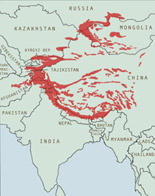 In a world first event, in October 2013, leaders in the governments of all 12 snow leopard range countries came together at the Global Snow Leopard Forum initiated by the President of Kyrgyz Republic, Mr Almazbek Atambayev.
In a world first event, in October 2013, leaders in the governments of all 12 snow leopard range countries came together at the Global Snow Leopard Forum initiated by the President of Kyrgyz Republic, Mr Almazbek Atambayev.
At that meeting in the Kyrgyz Republic’s capital, Bishkek, the 12 countries agreed that the snow leopard and the high mountain habitat it lives in, is too precious to let disappear.
Snow leopards don’t understand national boundaries and often cross from one country to another across high mountain passes when they are searching for food, places to rest or new mates. And this is the main reason why the fact these countries are all working together is such a big thing. Now they can identify where their biggest snow leopard numbers are and work with each other to protect them rather than each country working alone as they have done for the last 10-20 years.
2015 Year of the snow leopard will support trans-country co-operation to save the cats
To help spread the word amongst the people, government authorities and conservation groups in each country, designated 2015 as International Year of the Snow Leopard in Afghanistan, Bhutan, China, India, Kazakhstan, Kyrgyz Republic, Mongolia, Nepal, Pakistan, Russia, Tajikistan and Uzbekistan.
Poaching, habitat destruction and retaliation killing by herders who fear for their livestock, threatens the beautiful snow leopard in all these range countries. Numbers are estimated at dangerously low 3920 – 6390. But in a world first, in Bishkek in 2013 and 2014, the government leaders and conservation agencies agreed “the snow leopard is an irreplaceable symbol of our nations’ natural and cultural heritage and an indicator of the health and sustainability of mountain ecosystems”.
To show how seriously the governments are taking their pledges to help snow leopards they signed the Bishkek Declaration.The Declaration launched the Global Snow Leopard and Ecosystem Protection Program (GSLEP) is to conserve the snow leopard and its high-mountain ecosystems. These eco-systems incidentally are also the watershed for a third of the world’s population and will negatively impact millions of people seriously if they are not protected. This region also sustains the pastoral and agricultural livelihoods of traditional village and herder communities which depend on biodiversity for food, fuel, fodder, and often, medicine. To protect these iconic cats, the governments are also supporting their own people, many of whom live in poverty.
Snow leopard range country representatives have worked hard and identified 20 key snow leopard habitats, that is, areas where the largest populations of the cats live. During this year of the Snow Leopard, it’s hoped that they will share the story of why the cats should be protected through school activities, community meetings, dance and theatre, cultural events and across their countries’ media.
Our friends at the Snow Leopard Conservancy, the Snow Leopard Trust and Panthera Snow Leopard program are continuing with their vital research work, community education, supporting villagers to protect livestock, helping local women gain an income through snow leopard tourism and more. Check out their websites to see their work during 2015 International Year of the Snow Leopard and support them if you can.
We hope you can join us during the 2015 International Snow Leopard Year.







Comments on this entry are closed.